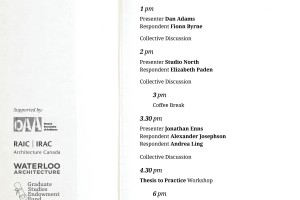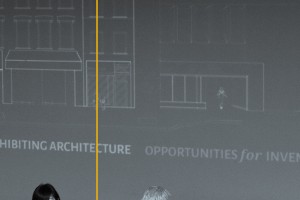The following essay by Shuyin Wu, currently an M2 student at Waterloo Architecture, is one of three winners of the inaugural Moriyama RAIC International Prize student scholarship. The $5,000 prizes were awarded earlier this month for the best essays in response to the question, “Why Do I Want to be an Architect?” The student scholarship is awarded in conjunction with the Moriyama RAIC International Prize, a new biennial award of $100,000 established by Canadian architect Raymond Moriyama, the Royal Architectural Institute of Canada (RAIC), and the RAIC Foundation. This year’s award went to architect Li Xiaodong of China for the Liyuan Library on the outskirts of Beijing. Read the full text of Wu’s winning essay below.
Yaodong
by Shuyin Wu
A poet uses a pen to make space speak the unspeakable. As an architectural student, I like to trace a pen upon the skin of the city, hearing, for example, the sound of a continuous texture cut by intervals of abrupt silence when the pen dips down into the eroding holes on the stone.
To me, Chinese cave dwelling – yaodong – is an area of practice that I will pursue for my master’s thesis study and long after. It is a reconciling between nature and culture, death and birth, silence and screams. Yao means beehive-like structures used throughout China’s countryside to fire bricks and tiles. Dong means caves, recessed cavities, or holes in the earth. It is one of the earliest forms of human shelter.
Today, 30-40-million people still live in yaodong homes, where their ancestors lived thousands of years ago. From primitive time’s worship for the female body, to the caves of Taoism, the yaodong tradition sustains people’s spiritual belief of exorcism and blessing. When people die, they are buried in caves near their homes; when people marry, their first night of marriage is called “into the caves.” Being inside a yaodong feels like being inside mother’s womb. Yaodong’s feminism comes from its internal form without external shape.
A yaodong’s carrier is the courtyard, the courtyard’s carrier is the village; the village’s carrier is a mountain or ravine, or the Loess plateau. Villages are integrated into the environment with low impact.
Yaodong dwellings are typically carved out of a hillside or excavated horizontally from a square hole in the earth, which serves as a sunken courtyard. During construction, the soil removed from a hill can be reused. After the yaodong’s time is up, it is buried again and returned to nature without a trace as time flows.
Because yaodong construction is cheap, quick, easy, and energy-saving, it has survived the warring states and provided shelter for refugees, the homeless, and soldiers in preparation for critical battles. The yaodong, where Chairman Mao lived for 13 years, became regarded as a sacred place of revolution and played an important role in both political and popular culture.
Unfortunately, for most of history, yaodong houses have been associated with poverty and backwardness. Today’s Chinese architecture is based upon the framework theorized by architectural historians Liang Sicheng and Lin Huiying. They suggested that only one dominant architecture – the standard timber structure which was the official structure of Northern royal palaces and temples– could represent China’s national style. This stance led to the dismissal of China’s rich culture diversity. The multiple construction systems and building types, especially the regional architecture of remote areas and minority communities, were largely excluded in their work.
Same as anywhere in the world, professional architecture has done much to prevent ordinary members of the community from interpreting their value systems through their homes and has inhibited their capacity to shape their domestic environment. In recent years, China has risked social tension through urbanization and the main reason is the income gap between different classes of citizens. For migrant workers who face sky-high property prices, the only option is to live in urban villages and even underground. I want to be an architect to re-conceive yaodong as a new shelter – a spiritual, as well as a physical shelter.
This cave- dwelling study not only treats the yaodong as a shelter for living but also as an urban intervention. It envisions yaodong buildings, not only as a physical substructure of landscape in remote areas, but also a vital force for regenerating cultural, social, and economic life.
The new yaodongs could engender a feeling of community and hope for the future among the inhabitants of rural communities. We should not simply ban or deconstruct them. Instead of accepting the condition as what it is, we should try to transform their features through positive design methods.
My first proposal is an underground dance centre. China has a long tradition of dancing, and people in the Loess soil dance as they pray for the rain. Through the dancer’s movement, space is filled with energy and lightness. By designing a cast-glass screen for its only façade, I hope to solve the lighting issues by brightening the interior with dispersion of light.
I recall an experience in Capri on a school field trip. After climbing a rock, I started making my way back toward my companions in the water. I called their names but failed to catch their attention. This feeling of isolation struck me strangely as if I was in my ghostly form as if I had died while I was climbing the rock. Rome, the city we studied, has this ability for one to feel like resurrecting from a massive tomb, a puzzling underworld where everything has aged so well.
Since then, I wear this invisible veil in order to understand the silence of statue and stone better. Once, they were particles in the air, then they became stone hard, and lost their ability of flight. Once, they were sculpted by artists whose hands sculpted like wind, but now they were dead. They are immobile and speechless now, but some invisible spirits must float in between stone and us, helping us communicate with the past.
Yaodong to me is a memory box as remote as the earth, with layers of dust buried over it. To re-conceive yaodong, I want to stir the dust buried over it for thousands of years.
I wish through juxtaposition of light and darkness, lightness of glass and heaviness of earth, that a new dynamic may be channeled inside the cave.






Leave a Reply